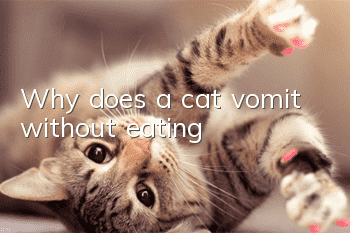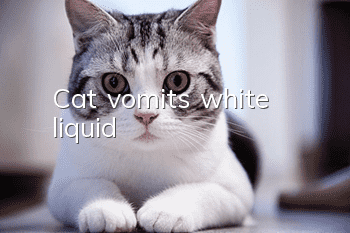Why does a cat vomit without eating?

The following may be the reasons why cats are vomiting despite not eating. One is food spoilage or allergies, the other is hair ball disease, the third is irritation caused by changing the new environment, the fourth is gastroenteritis and imbalance of intestinal flora, and the fifth is irritation caused by changing the new environment. It is a viral infection (such as feline distemper, cat-borne infection), so it is necessary to observe the cat’s diet, vomiting frequency and vomiting contents, etc., to help find the cause of the cat’s vomiting and relieve its symptoms.
1. Food spoilage or allergies
Pay attention to the diet, the type and amount of food eaten before vomiting, and check whether the cat's vomiting and loss of appetite are caused by cat food and snacks. Changing cat food brands, food deterioration, or allergic ingredients in food can cause cats to vomit. Owners need to adjust their cats' food and observe their appetite. After checking the diet,
2. Hairball syndrome
Cats licking too much hair can cause hairball syndrome, causing gastrointestinal discomfort and vomiting. Owners need to pay attention to the frequency of vomiting and the content of the vomiting, whether it is retching multiple times and whether there is a lot of hair in the vomitus. This situation can be effectively relieved by giving the cat hair removal cream regularly.
3. Environmental changes
If the environment has been changed recently, or the cat has gone out recently, the cat may vomit due to stress. The owner should pay attention to letting the cat eat more Rest and spend more time with your cat to reduce stress factors and ease the cat’s mood. In the above situations, if the owner takes good care of the situation, the cat will return to normal soon.
4. Gastrointestinal problems
Gastrointestinal problems can also cause cats to suffer from loss of appetite, vomiting, and cats also have obvious listlessness. The owner can observe the cat's defecation situation. If diarrhea or bloody stool occurs, the owner must send the cat to the hospital for treatment in time. Gastrointestinal inflammation and the growth of harmful intestinal flora can cause gastrointestinal discomfort in cat owners, leading to vomiting and inability to eat. In this case, the cat needs to be rehydrated in time. It is recommended that the owner give the cat some glucose water.
5. Infection with viruses
Cats may also vomit when infected with viruses, such as highly contagious feline distemper and abdominal transmission from cats, which is why owners are more worried. Owners need to carefully observe whether the cat has diarrhea, its mental state, and whether it has a fever (normal body temperature is around 38 to 39 degrees). We would like to remind everyone who has the above symptoms to go to the pet hospital to seek help from a professional doctor in time, and do not take it easy on your own. Buy medication for treatment. After the diagnosis is made at the pet hospital, treatment can be carried out according to the doctor's treatment plan.
- What are the appearance characteristics of Burmese cats?
- What are the taboos in cat diet?
- How long does it take for a cat to undergo external deworming after taking a bath?
- Why do cats like to hold hands?
- How to wean a kitten?
- Can cats suffer from depression? What are the symptoms of depression in cats?
- What should I do if my cat wets the bed?
- How should cats be trained? Let’s learn some tips on training cats!
- Do you know what the different meows of cats mean?
- Are cats color blind? What are cats color blind?



